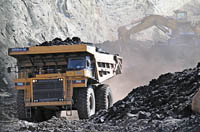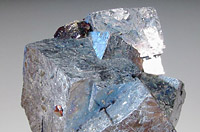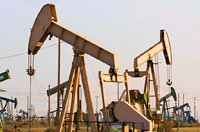
"... the greatest value is added by the geologist who starts with nothing other than some ideas and goes out into the desert and finds an orebody" 1 |
Here are a few web links. Let me know if you find others of interest, and I'll post them for the class to use.
Infomine. Literally a mine of news and information. You might want to check their commodities pages for historical metal and energy prices. Tin, rhodium, potash ... it's all there. This is a neat and informative site. Lots to learn from digging around here. There are commonly about a thousand geology jobs on offer here, hundreds in the US, more overseas.
Identification of sulfide and oxide (mostly) minerals in reflected light. We won't have time to cover this in any detail, but take a look to see: (i) How opaque minerals can be identified with a reflected light microscope, and (ii) Typical textures of sulfide-bearing rocks and mineral intergrowths.
Flickr gallery of amazing black smoker photos from the Neptune project. These are from the Endeavour hydrothermal vent field on our own local Juan da Fuca Ridge. The University of Washington is a lead player in the Neptune project.
While we're on the subject of black smokers and seafloor sulfide deposits, here is a terse but comprehensive and authoritative review of so-called "Sedex" deposits: USGS Sedex summary paper. "Sedex" is short for "sedimentary exhalative". "VHMS" deposits (volcanic-hosted massive sulfides) are a subset of sedex deposits.
Link to a brief history of the Monte Cristo mining district in the central Cascades. Here's the Wikipedia article. Monte Cristo is now a ghost town with a few houses and old mine buildings still standing, an hour or two's walk up the trail from Barlow Pass on the Mountain Loop Highway. Starting in summer 2013 the Forest Service began cleaning up acid mine drainage from the worst of the old mine entrances and tailings dumps around the townsite and up in Glacier Basin. The Ag-Pb-Zn vein systems that drew prospectors to the area in the 1870s and 1880s are still visible in cliffs and outcrops above the townsite, but very inaccessible.



